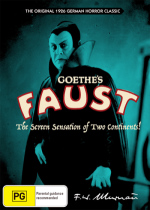Faust (Bounty) (1926) (NTSC) |
|
Faust (Bounty) (1926) (NTSC) |
|


|
| BUY IT |
| General | Extras | ||
| Category | Horror | Audio Commentary-Film critic John Noonan and Leslie Morris | |
| Rating |

|
||
| Year Of Production | 1926 | ||
| Running Time | 106:19 (Case: 116) | ||
| RSDL / Flipper | Dual Layered | Cast & Crew | |
| Start Up | Menu | ||
| Region Coding | 1,2,3,4,5,6 | Directed By | F. W. Murnau |
|
Studio
Distributor |
Bounty Films | Starring |
Gosta Ekmann Emil Jannings Camilla Horn William Dieterle Werner Fuetterer |
| Case | Amaray-Transparent | ||
| RPI | ? | Music | None Given |
| Video (NTSC) | Audio | ||
| Pan & Scan/Full Frame | None |
English Dolby Digital 2.0 mono (192Kb/s) English Audio Commentary Dolby Digital 2.0 (192Kb/s) |
|
| Widescreen Aspect Ratio | None | ||
| 16x9 Enhancement | Unknown | ||
| Video Format | 480i (NTSC) | ||
| Original Aspect Ratio | 1.33:1 | Miscellaneous | |
| Jacket Pictures | No | ||
| Subtitles | English | Smoking | No |
| Annoying Product Placement | No | ||
| Action In or After Credits | No | ||
When an Archangel (Werner Fuetterer) and the demon Mephisto (Emil Jannings) argue whether God or the Devil should have dominion over the Earth, they make a wager; if Mephisto can corrupt the soul of Faust (Gosta Ekmann), a pious elderly alchemist, he will win. Mephisto gets to work and causes a plague to ravage Faust’s town; Faust, in anguish as neither science nor prayer can help the townspeople, calls on the Devil to help. Mephisto materialises and offers Faust a deal; if Faust renounces God for one day he can have whatever he desires. Faust agrees and starts to cure people of the plague. But the townspeople believe that he is in league with the Devil (as indeed he is) and stone him. Faust is distraught and about to commit suicide when Mephisto stops him; he shows Faust his youthful self and an apparition of a beautiful, naked woman and offers to take Faust to her. The beautiful young woman is the Duchess of Parma and it is her wedding day. Mephisto and Faust fly to Parma on Mephisto’s cloak; there Mephisto kills the Duke and Faust takes the Duchess off. However, just as Faust is about to climb into bed with the Duchess, Mephisto tells him that his one day has ended. Filled with lust, Faust extends the deal.
Some time later Faust is tired of debauchery and decides to return home. It is Easter, and Faust sees the beautiful and pure maiden Gretchen (Camilla Horn) on her way to Mass and is determined to have her, ordering Mephisto to help. A charmed necklace later and Faust has Gretchen in bed. However, Mephisto alerts Gretchen’s brother Valentin (William Dieterle) who breaks in on the lovers. Faust and Valentin fight; Mephisto stabs Valentin in the back, then arouses the townspeople with cries of “Murder”. Faust and Mephisto flee. Gretchen is shunned by the townspeople. Later that year she gives birth. At Christmas Gretchen is cold and destitute; refused help by the townspeople, her baby dies in the snow. Gretchen is accused of murdering her child and is condemned to be burnt at the stake. Faust becomes aware of Gretchen’s plight. On the day of her execution Faust redeems himself by throwing himself onto her funeral pyre and in death the lovers are reunited and ascend to heaven; Mephisto loses his bet, as love triumphs.
Faust (Faust: Eine deutsche Volkssage) was the last feature made by director F. W. Murnau (Nosferatu) in Germany before leaving for the United States. The film looks stunning; Murnau’s use of smoke, light and shadow is exceptional and the film includes such wonderful imagery as the huge black figure of Mephisto towering over the town or the horsemen of the Apocalypse. The effects, including double or triple exposures, or exposures with individuals of different size, are obviously primitive but are still very impressive. Gosta Ekmann is fine as the elderly Faust but less effective as the young Faust; instead the power of the film, and the sadness, comes from the destruction of innocence in the form of the lustrous beauty Camilla Horn while the black comedy comes from the very expressive face and gestures of Emil Jannings. But then again, bad guys often get the best scenes!! Jannings was a leading man in films such as the silent Quo Vadis? in 1924, received the equivalent of what would become the best actor Oscar for The Way of All Flesh (1927) and The Last Command (1928) and made the transition to talkies in such films as The Blue Angel in 1930 with Marlene Dietrich. Later in life he became a mainstay of the Nazi film industry during WW2.
Most fans are likely to have a copy of Faust as it has been released on numerous occasions around the world on DVD and Blu-ray with different specifications and extras. DVDBeaver provides some examples here. There was also a DVD released in Australia back in 2002; the review of that version can be found here. So what is the source of this new release from Bounty and does it have anything new to offer?
There were a number of versions of the film, some created by Murnau himself including changes he made specifically for the US market. Murnau also shot scenes different ways; for example in an early carnival scene some shots use a live bear, others a man in a suit. Restorations have been made using different prints: the versions available on home video (see the DVDBeaver link above) are either the “Domestic” version running 106 minutes or the “Export” version running 115 minutes. There are also a number of soundtrack options available; a harp score by Stan Ambrose, a couple of orchestral scores including one by Timothy Brook and a piano score by Perez de Azpeitia. The previous release in Australia was the Export version of the film. It was in PAL with the orchestral score by Timothy Brook and included an audio commentary written by film historian Peter Spooner that the reviewer described as superb.
This new release from Bounty is clearly not from the same source as the earlier release: it is the Domestic version with German inter-titles and English subtitles, in NTSC and it features a piano score which may be by Perez de Azpeitia although the DVD box cover and the print give no indication. It also has a new audio commentary by Australian film critic John Noonan recorded for this Bounty release.
Faust is an expressionist gem of a film, audacious, innovative, powerful and sad, its theme the corruption of innocence and the conflict between good and evil. It has a cast of thousands at the wedding and in crowd scenes, elephants, the special effects remain impressive as is the use of light and shadow. Faust, after more than 90 years, still remains an impressive film.
Faust is presented in the 1.33:1 ratio, in the NTSC format. My computer reads the film as 16x9; it does display as 4x3 with side bars on my widescreen TV.
There have been a number of restorations of the film – it is interesting that in this release during a frame jump at 101:39 a text on screen fleetingly reads “Film Restoration & Conservation, Bologna”. We are dealing with a film that was shot over 90 years so damage is to be expected. Small marks are frequent plus a couple of larger ones, there are scratches, minor macro-blocking, contrast changes and in two places (54:30, 78:18) the picture dissolves. The film looks quite soft, and Murnau’s frequent use of smoke and filters makes a number of scenes deliberately hazy. However, blacks are quite solid, shadow detail pretty decent and close-ups strong. Overall, I was quite happy with the print and I have seen films 50 years younger looking far worse. The scores have been adjusted as one cannot judge a film of this age against modern films.
White English subtitles automatically translated the German inter-titles and books. The layer change at 53:19 created a slight pause in the middle of a scene.
| Sharpness | |
| Shadow Detail | |
| Colour | |
| Grain/Pixelization | |
| Film-To-Video Artefacts | |
| Film Artefacts | |
| Overall |
Audio is Dolby Digital 2.0 (mono) at 192 Kbps; the audio commentary is also Dolby Digital 2.0 at 192 Kbps.
As a silent film, there was no dialogue or effects to comment on! The piano score was clear and there was no noticeable hiss, hum or distortion.
Obviously there are no lip synchronization issues.
| Dialogue | |
| Audio Sync | |
| Clicks/Pops/Dropouts | |
| Surround Channel Use | |
| Subwoofer | |
| Overall |
Bounty have tended to add fascinating extras to their silent classics releases such as Nosferatu or The Cabinet of Dr. Caligari but here they restrict themselves to a locally produced audio commentary as the sole extra.
This commentary was recorded for this Bounty release. Australian film critic John Noonan sits with Leslie Morris and they chat about German expressionism, the careers of Emil Jannings, Gosta Ekmann and Camilla Horn, the attitude to religion in the film, special effects, the fact that Mary Pickford and Lillian Gish were at one time cast, and F.W. Murnau. They get side-tracked and talk about things not related to the film, and laugh and make jokes, but do provide some insights into the film.
NOTE: To view non-R4 releases, your equipment needs to be multi-zone compatible and usually also NTSC compatible.
As noted, there are many different versions of Faust available. This new release has a unique commentary but not any of the extras available elsewhere.
Faust silent film released in 1926, has universal themes and still has the power, images, effects and performances to pull you in, and keep you there during its running time, which passes quickly. I had not seen the film before and I was impressed.
Film buffs and fans of the film will already have a copy so your interest in the audio commentary will be the factor in deciding on a purchase of this release. If you don’t have Faust, however, this is your chance to pick up this gem of German expressionism.
| Video | |
| Audio | |
| Extras | |
| Plot | |
| Overall |
| Review Equipment | |
| DVD | Sony BDP-S580, using HDMI output |
| Display | LG 55inch HD LCD. This display device has not been calibrated. This display device is 16x9 capable. This display device has a maximum native resolution of 1080p. |
| Audio Decoder | NAD T737. This audio decoder/receiver has not been calibrated. |
| Amplification | NAD T737 |
| Speakers | Studio Acoustics 5.1 |